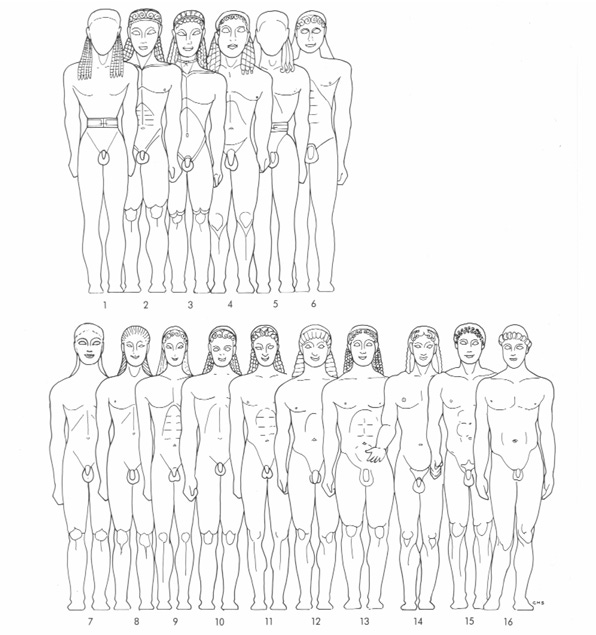The Greek Cult of the Body
Part One - the ancient Greek body, discovering the ideal human
The ancient Greeks famously celebrated the human body, elevating male physical beauty and athletic excellence to near-ideal status: a “cult of the body”. It is hard to separate this cult out from the rest of Greek life as merely aesthetic, instead it intertwined with their philosophy, religion, and art. As one scholar notes,
the body was central to the visual culture of ancient Greece, reflecting an obsession with physical beauty, integrity, dynamism, and power
-Art, Desire, and the Body in Ancient Greece (1997) A. Stewart
One could argue that the Greeks invented the human body. A civilisational moment in the human story where the body becomes idealised, trained, refined, sculpted and moulded - reaching for the divine - as opposed to the attitudes typical of elsewhere such as casual nudeness for men and women of all ages, or a shameful seclusion of the body in clothes. Debates over whether Greek art represents something real or imaginary have raged since the time of the Romans, and it is hard to point to another style and period of art which has had more cultural impact.
Personally I think the Greeks were well aware that their statues did not represent most people, nor did they want them to. These images were a tightrope, between man and the gods, between the human form broken under the weight of the world and the human form embodying the values of youthful, violent, freedom.
Why the body? What did it look like?
It was not until Egypt that art broke its enslavement to nature…
In Egypt is forged the formalistic Apollonian line that will end in modern cinema, master genre of our century. Egypt invented glamour, beauty as power and power as beauty. Egyptian aristocrats were the first Beautiful People. Hierarchy and eroticism fused in Egypt, making a pagan unity the west has never thrown off…
This masculine hardness is an abolition of female interiority. There are no warm womb-spaces in aristocratic Egyptian art. The body is a shaft of frozen Apollonian will. The flatness of Egyptian wall-painting and relief serves the same function, obliterating woman’s inner darkness. Every angle of the body is crisp, clean, and sunlit. Sagging maternal breasts of the Willendorf kind usually appear, oddly enough, only on male fertility gods like Hapi, the Nile god. Egypt is the first to glamourize small breasts. The breast as vernal adornment rather than rubbery milk sac, outline rather than volume: Apollonian Egypt made the first shift of value from femaleness to femininity, an advanced erotic art form.
- Sexual Personae (1990) C. Paglia
Camille Paglia describes in the second chapter of her magnum opus Sexual Personae, how the ancient Egyptians gave birth to the ‘western eye’, which was an Apollonian fixation with lines, surfaces, symmetry and hardness. The earliest Greek artworks which depict the human form are clearly influenced by this style, in what art historian Ernst Gombrich describes as ‘a Great Awakening’ and ‘the Greek Revolution’. The freestanding kouroi statues (male youths) show us a vision of the young male form, part way idealised, part following the rules of Egyptian sculpture. Diamonds sweep outwards from the central omphalos, and the body is proportioned unnaturally, with large staring eyes. In the hands of the Greeks it takes several centuries for this to become more natural. Between the 7th and 5th centuries BC the kouroi are swallowed up by the Greek expressive imagination and become life-like, even moving towards an uneven posture with remarkable skill.

One striking feature that should be highlighted though, is that the kouroi were virtually always naked - unlike their Egyptian counterparts - which tells us that Greek priorities when depicting human bodies emphasised nudity from the outset.
The Greeks discovered in the nude two embodiments of energy, which lived on throughout European art almost until our own day. They are the athlete and the hero; and from the beginning they were closely connected with one another.
-The Nude : A Study of Ideal Art (1957) K. Clark
The Greeks felt so strongly about nudity that it was thought to have a magical effect (c.f. the apotropaic use of the phallos, gestures against the evil eye, etc.). Their athletes were thought to be protected in some way by their nudity.
-Etruscan Dress (1975) L. Bonfante
The origins of nudity amongst warriors and athletes is contested, even within Greek sources, and they include: Acanthus the Lacedaemonian, Orsippos of Megara and orders by the Athenian archon Hippomenes. One particular niche type of kouroi often found in eastern Greece were depicted with a draped khiton-like garment, around 40 examples exist, but these stand out as exceptions to the rule.
Another famously enigmatic motif within this period of artwork is the ‘Archaic smile’, that aloof, relaxed smile on the faces of all the kouroi. Many theories exist as to the meaning of this facial expression, one which serves to de-individualise each statue, including the notion that it was simply the easiest face to carve on stone at that time. I prefer Richard Neer’s explanation:
Keep reading with a 7-day free trial
Subscribe to Grey Goose Chronicles to keep reading this post and get 7 days of free access to the full post archives.

